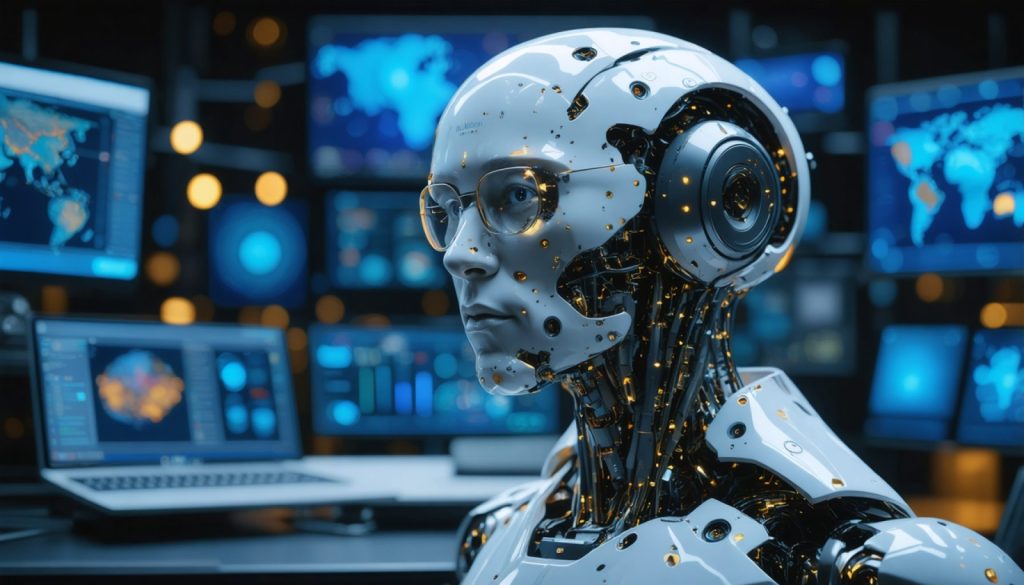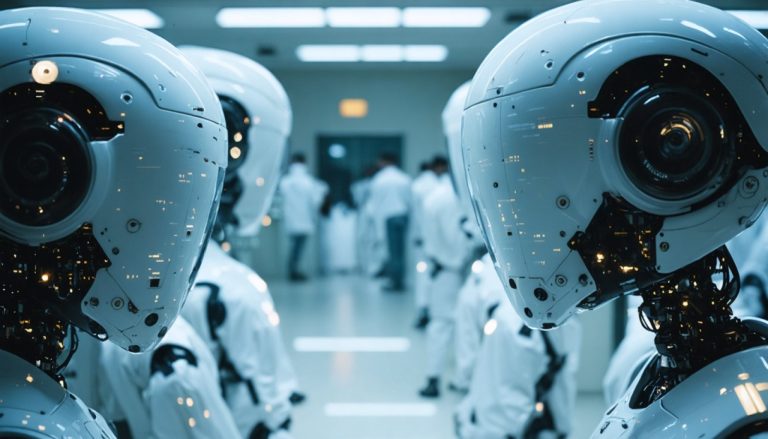
- AI is poised to revolutionize industries akin to the Industrial Revolution, emphasizing efficiency and transformation across sectors.
- In healthcare, AI automates administrative tasks, allowing medical professionals to focus on patient care and enabling personalized treatments.
- AI in education offers personalized learning paths, reducing teachers’ administrative burdens and enhancing student creativity.
- Blue-collar sectors see AI augment human roles, improving precision and efficiency in tasks like manufacturing and construction.
- The hospitality industry benefits from AI handling logistics, permitting staff to enhance guest experiences.
- Challenges include potential job displacement, emphasizing the importance of retraining and upskilling to adapt to AI’s integration.
- AI can help realize visions of reduced workweeks, demanding socioeconomic adjustments and discussions on universal basic income.
- Overall, AI promises to expand human potential, transforming tedious tasks into opportunities for growth and leisure.
The world stands on the precipice of a technological transformation as Artificial Intelligence (AI) edges closer to revolutionizing our daily lives. With its ceaseless evolution, AI is reshaping industries with a profound impact that mirrors the seismic shifts of the Industrial Revolution. Visionaries like Bill Gates champion AI’s potential, envisioning a society that thrives on augmented efficiency in healthcare, education, and even traditionally manual sectors.
Imagine a world where doctors can dedicate their full attention to patients, liberated from the endless cycle of administrative tasks. AI promises this reality. By automating routine duties, AI affords medical professionals the luxury of time—an irreplaceable resource. Sophisticated algorithms analyze medical data with unprecedented accuracy, foreshadowing a future where personalized treatments become the norm rather than the exception. Healthcare systems, bolstered by AI’s precision and speed, can potentially extend their reach to underserved regions, bridging the gaps in accessibility and care.
The education landscape is similarly ripe for enhancement. Teachers, often overwhelmed by administrative burdens and large class sizes, may soon find relief through AI’s intelligent systems. These platforms adapt to the learning curve of each student, crafting bespoke educational paths that address individual needs. Such technology not only personalizes learning but also liberates educators to focus on cultivating creativity and critical thinking in the classroom, fostering a richer and more engaging educational environment.
Meanwhile, AI’s infiltration into blue-collar roles heralds an era of unprecedented change. Factories buzz with smart machines that tackle repetitive tasks with machine-precise efficiency, transforming human workers into supervisors of a seamless digital symphony. In construction, AI promises to execute complex labor-intensive tasks like bricklaying with immaculate precision, reshaping the workforce into one that harmonizes human creativity with robotic precision.
The hospitality sector too joins this digital renaissance. AI quietly takes over logistical tasks, allowing staff to invest in what truly matters: crafting unforgettable guest experiences. As robots manage back-end operations, employees can focus their energies on delivering the human touch that lies at the heart of hospitality.
Yet, such a profound transition is not without challenges. The specter of job displacement looms large, threatening the livelihoods of those unprepared for this digital evolution. As AI redefines work, the need for retraining and upskilling becomes critical—industries and governments must navigate this landscape thoughtfully to ensure workers have opportunities to adapt and thrive.
This AI-driven future aligns with the long-held dreams of thinkers like John Maynard Keynes, who once predicted that technological advancement would dramatically shorten workweeks. The realization of this vision, however, demands a rethink of economic and societal norms—a revaluation of work-life balance and perhaps the establishment of safety nets like universal basic income to ease the transition.
Gates’s vision of AI is not a story of cold machine takeover, but one where technology enriches human potential, transforming drudgery into opportunity and opening new vistas for leisure and personal development. As the boundaries of what’s possible expand, AI stands to be a partner—an enabler of a future where humanity can flourish in unprecedented ways.
How AI is Changing Our World: What You Need to Know Now
The Impact of AI on Various Sectors and What Lies Ahead
Artificial Intelligence (AI) is undeniably transforming the landscape of several industries, reminiscent of the Industrial Revolution’s impact. Here’s a detailed look at potential advancements, challenges, and preparatory steps individuals and organizations can take to harness AI’s power.
Healthcare: Personalized Treatments and Efficiency
Additional Facts:
– AI in Diagnostics: AI algorithms are now capable of diagnosing conditions such as diabetic retinopathy and certain types of cancer with accuracy comparable to trained specialists. A study published in The Lancet showed AI systems diagnosing eye diseases from retinal scans with high precision.
– Remote Monitoring: Wearables and remote monitoring systems that leverage AI help in tracking chronic conditions, reducing hospital visits.
How-To Steps & Life Hacks:
– For Patients: Use AI-powered health apps for personalized health insights and advice. Apps like MyFitnessPal or Fitbit can track health metrics and offer suggestions.
– For Providers: Implement AI-powered management systems to reduce administrative workload, thereby allowing more patient interaction time.
Education: Personalized Learning Paths
Real-World Use Cases:
– Adaptive Learning: Platforms like Carnegie Learning use AI to provide personalized learning experiences, adjusting content based on student performance in real-time.
Market Forecasts & Industry Trends:
– The AI in education market is projected to grow at a CAGR of 40% from 2021 to 2030 as per Allied Market Research, highlighting an increase in adaptive learning tools and educational bots.
Blue-Collar Sectors: Automation and Supervisory Roles
Features & Specs:
– Automated robotic welding systems now include AI components for error detection, improving efficiency and safety in manufacturing.
Pros & Cons Overview:
– Pros: Increased precision, reduced human error, lower operational costs.
– Cons: Potential job displacement, high initial investment costs.
Hospitality: Enhancing Guest Experiences
Reviews & Comparisons:
– AI chatbots (e.g., IBM’s Watson Assistant) versus traditional customer service: AI provides quicker response times and handles requests 24/7, but lacks the nuanced human touch.
Key Challenges: Job Displacement and Economic Adjustments
Security & Sustainability:
– Data Security: Increased data collection through AI necessitates robust cybersecurity measures. Compliance with regulations like GDPR is critical.
Controversies & Limitations:
– Concerns about biased AI algorithms that may reinforce existing inequalities have been raised. Continuous evaluation and ethical use of AI stand as necessary measures.
Insights & Predictions:
– Future workplace dynamics might lean towards a hybrid model where humans work alongside AI, requiring new skill sets centered around AI management and interpretation.
Actionable Recommendations
1. Upskill Continuously: Embrace online courses and certifications to stay competitive. Platforms like Coursera and edX offer AI-related courses.
2. Implement AI Thoughtfully: Start small by integrating AI into specific processes to gauge its impact before full implementation.
3. Plan for Transition: Companies should offer training programs focused on transitioning employees to new roles where AI tools are utilized.
4. Stay Updated: Follow trends and updates on AI advancements through trusted sources such as Forbes or BBC.
As AI reshapes our world, it’s imperative for individuals and organizations to proactively adapt and find ways to leverage these technologies for maximum benefit. By keeping an eye on trends and preparing for changes, we can mitigate risks while embracing new opportunities AI offers.



